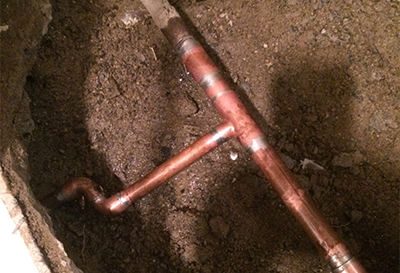Exactly how to Examine If Your House Has a Covert Leakage
Exactly how to Examine If Your House Has a Covert Leakage
Blog Article
What are your insights and beliefs on Detecting hidden plumbing leaks?

Early detection of leaking water lines can alleviate a possible calamity. Some little water leakages may not be visible.
1. Analyze the Water Meter
Every residence has a water meter. Examining it is a proven way that helps you discover leaks. For starters, shut off all the water sources. Ensure nobody will flush, utilize the faucet, shower, run the washing device or dishwashing machine. From there, go to the meter as well as watch if it will alter. Because nobody is utilizing it, there should be no activities. That suggests a fast-moving leakage if it moves. If you spot no changes, wait an hour or two and also check back once more. This indicates you may have a slow-moving leakage that could also be underground.
2. Examine Water Intake
Examine your water bills and track your water intake. As the one paying it, you must discover if there are any type of inconsistencies. If you find sudden changes, despite your intake being the same, it means that you have leakages in your plumbing system. Keep in mind, your water bill need to drop under the same array each month. A sudden spike in your bill shows a fast-moving leak.
On the other hand, a steady boost monthly, despite having the same behaviors, shows you have a sluggish leak that's likewise gradually escalating. Call a plumber to extensively check your property, particularly if you really feel a cozy area on your flooring with piping underneath.
3. Do a Food Coloring Test
When it comes to water consumption, 30% comes from toilets. If the color somehow infiltrates your bowl during that time without flushing, there's a leak in between the container and also dish.
4. Asses Outside Lines
Don't forget to inspect your exterior water lines too. Ought to water leak out of the connection, you have a loose rubber gasket. One little leakage can waste loads of water and spike your water bill.
5. Inspect and also Assess the Circumstance
House owners ought to make it a practice to check under the sink counters and also also inside closets for any bad odor or mold growth. These 2 red flags suggest a leak so prompt focus is needed. Doing routine examinations, even bi-annually, can conserve you from a major problem.
A lot more notably, if you recognize your residence is already old, maintain a watchful eye on your heaters, tubes, pipes and so on. Look for discolorations as well as weakening as the majority of devices and pipes have a life span. They will likewise normally wear away because of damage. If you believe leaking water lines in your plumbing system, don't await it to escalate. Call a professional plumber today so you don't wind up with a dreadful mess in your home.
Early discovery of dripping water lines can minimize a possible calamity. Some tiny water leaks may not be noticeable. Examining it is a proven means that helps you discover leaks. One tiny leak can squander heaps of water and also increase your water bill.
If you suspect leaking water lines in your plumbing system, don't wait for it to intensify.
WARNING SIGNS OF WATER LEAKAGE BEHIND THE WALL
PERSISTENT MUSTY ODORS
As water slowly drips from a leaky pipe inside the wall, flooring and sheetrock stay damp and develop an odor similar to wet cardboard. It generates a musty smell that can help you find hidden leaks.
MOLD IN UNUSUAL AREAS
Mold usually grows in wet areas like kitchens, baths and laundry rooms. If you spot the stuff on walls or baseboards in other rooms of the house, it’s a good indicator of undetected water leaks.
STAINS THAT GROW
When mold thrives around a leaky pipe, it sometimes takes hold on the inside surface of the affected wall. A growing stain on otherwise clean sheetrock is often your sign of a hidden plumbing problem.
PEELING OR BUBBLING WALLPAPER / PAINT
This clue is easy to miss in rooms that don’t get much use. When you see wallpaper separating along seams or paint bubbling or flaking off the wall, blame sheetrock that stays wet because of an undetected leak.
BUCKLED CEILINGS AND STAINED FLOORS
If ceilings or floors in bathrooms, kitchens or laundry areas develop structural problems, don’t rule out constant damp inside the walls. Wet sheetrock can affect adjacent framing, flooring and ceilings.
https://www.servicemasterbyzaba.com/blog/how-to-detect-water-leakage-in-walls/

As a keen reader about Hacks to detect leaks, I thought sharing that piece was a smart idea. Be sure to take the time to distribute this blog posting if you enjoyed it. Bless you for your time. Visit again soon.
Report this page